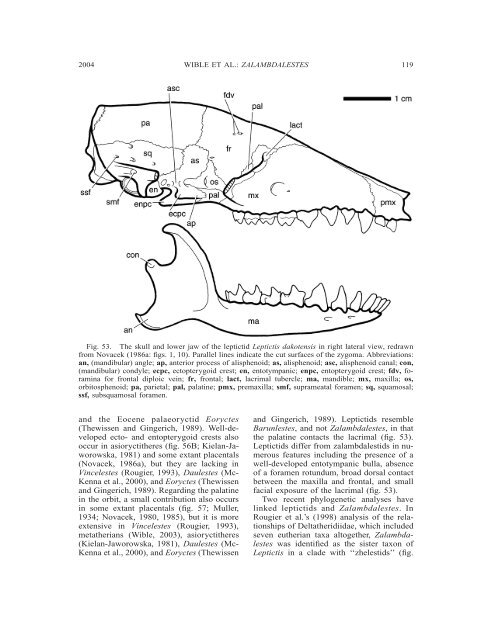zalambdalestes - American Museum of Natural History
zalambdalestes - American Museum of Natural History
zalambdalestes - American Museum of Natural History
You also want an ePaper? Increase the reach of your titles
YUMPU automatically turns print PDFs into web optimized ePapers that Google loves.
2004 WIBLE ET AL.: ZALAMBDALESTES<br />
119<br />
Fig. 53. The skull and lower jaw <strong>of</strong> the leptictid Leptictis dakotensis in right lateral view, redrawn<br />
from Novacek (1986a: figs. 1, 10). Parallel lines indicate the cut surfaces <strong>of</strong> the zygoma. Abbreviations:<br />
an, (mandibular) angle; ap, anterior process <strong>of</strong> alisphenoid; as, alisphenoid; asc, alisphenoid canal; con,<br />
(mandibular) condyle; ecpc, ectopterygoid crest; en, entotympanic; enpc, entopterygoid crest; fdv, foramina<br />
for frontal diploic vein; fr, frontal; lact, lacrimal tubercle; ma, mandible; mx, maxilla; os,<br />
orbitosphenoid; pa, parietal; pal, palatine; pmx, premaxilla; smf, suprameatal foramen; sq, squamosal;<br />
ssf, subsquamosal foramen.<br />
and the Eocene palaeoryctid Eoryctes<br />
(Thewissen and Gingerich, 1989). Well-developed<br />
ecto- and entopterygoid crests also<br />
occur in asioryctitheres (fig. 56B; Kielan-Jaworowska,<br />
1981) and some extant placentals<br />
(Novacek, 1986a), but they are lacking in<br />
Vincelestes (Rougier, 1993), Daulestes (Mc-<br />
Kenna et al., 2000), and Eoryctes (Thewissen<br />
and Gingerich, 1989). Regarding the palatine<br />
in the orbit, a small contribution also occurs<br />
in some extant placentals (fig. 57; Muller,<br />
1934; Novacek, 1980, 1985), but it is more<br />
extensive in Vincelestes (Rougier, 1993),<br />
metatherians (Wible, 2003), asioryctitheres<br />
(Kielan-Jaworowska, 1981), Daulestes (Mc-<br />
Kenna et al., 2000), and Eoryctes (Thewissen<br />
and Gingerich, 1989). Leptictids resemble<br />
Barunlestes, and not Zalambdalestes, in that<br />
the palatine contacts the lacrimal (fig. 53).<br />
Leptictids differ from zalambdalestids in numerous<br />
features including the presence <strong>of</strong> a<br />
well-developed entotympanic bulla, absence<br />
<strong>of</strong> a foramen rotundum, broad dorsal contact<br />
between the maxilla and frontal, and small<br />
facial exposure <strong>of</strong> the lacrimal (fig. 53).<br />
Two recent phylogenetic analyses have<br />
linked leptictids and Zalambdalestes. In<br />
Rougier et al.’s (1998) analysis <strong>of</strong> the relationships<br />
<strong>of</strong> Deltatheridiidae, which included<br />
seven eutherian taxa altogether, Zalambdalestes<br />
was identified as the sister taxon <strong>of</strong><br />
Leptictis in a clade with ‘‘zhelestids’’ (fig.
















